As per decision taken by the NDA-I Government, out of 14 Railway Printing Presses 09 were to be closed and remaining 05 important Printing Presses were to be continued (because of having advanced modern web-offset printing) modernizing these 05 Printing Presses, procuring latest technology equipped Printing Machines….

No.AIRF/174 Dated: January 15, 2020
Hon’ble Minister for Railways,
Ministry of Railways
(Government of India),
Rail Bhawan,
New Delhi
Respected Sir,
Sub: Closure of the Printing Presses of the Indian Railways
As per decision taken by the NDA-I Government, out of 14 Railway Printing Presses 09 were to be closed and remaining 05 important Printing Presses were to be continued (because of having advanced modern web-offset printing) modernizing these 05 Printing Presses, procuring latest technology equipped Printing Machines.
A substantial amount was allocated worth crores of rupees for this purpose during the tenure of Shri Suresh Prabhakar Prabhu, the then Hon’ble Minister for Railways, and the said amount has already been spent to modernize these Printing Presses. One of the newly procured machines was installed in the Modern Ticket Printing Press at Howrah during his tenure as Minister for Railways, which was also inaugurated by him as M.R.
The requirement of the PRS is about 200 million of paper-based tickets per annum and more than 3000 million UTS Tickets because of percentage of Digital Mobile Tickets in case of UTS is around 02% only, whereas 98% requirement is of UTS Counter Tickets. So far as experience of outsourced private printers is concerned, example of Western Railway can be quoted; where work of printing of tickets was assigned to M/s Axis Media, Mumbai, which summarily failed and defaulted in timely printing and supply, for which Western Railway was compelled to beg from other Railway Zones.
The cost of Ticket Printing in the Railway Printing Presses is worked out to 11 paisa per ticket, which is below the market price.
Sufficient skilled and experienced manpower is available in these 05 Modernized Printing Presses; which is equipped with proper training to work on these latest technology Printing Machines. Some of the personnel were imparted training abroad for this purpose; on which Indian Railways had to spend a substantial amount.
Disadvantages of closure of the Printing Presses would be as under:-
(i) The entire newly procured latest technology printing machines would render condemn and shall have to be sold as scrap.
(ii) Manpower, available in these Presses, who have long experience of printing, shall also be rendered surplus, resulting in various problems of their proper redeployment for gainful utilization.
(iii) Total dependency on Outsourced Private Printing Presses would create serious problem of timely printing and supply of not only printed tickets, but also a number of other printed materials, which include Money Value Books, Operational and Safety Related Forms, Books etc., widely used by the Indian Railways.
Status of Howrah Printing Press is given hereunder for ready reference:-
CAPACITY VIABILITY
| S. No. | Components | Viable Areas |
| 1. | Technical Capacity | Staff orientation; staff development and training executed. |
| 2. | Human Resources | HR Management capacity, staff roles and responsibility improved. |
| 3. | Organizational structure and internal co-ordination | There is clear organizational structure in place with effective co-ordination among different zones from where printing jobs come pouring heavily. |
| 4. | HR data and staff profile | 1. a. Staff Strength -393
b. On Roll – 277. c. Vacancy – 116.
2. Age Profile
a. Staff age from 55-59 yrs.-135 b. Staff age from 51-54 yrs.-101 c. Staff age from 49-50 yrs.- 41
3. Year—wise Retirement
Year-wise Commutative
a. 2020 – 36 36 b. 2021 – 25 61 c. 2022 – 30 91 d. 2023 – 20 111 e. 2024 – 24 135 f. 2025 – 27 162 162 |
| 5. | Access to technical resources. | All Technical Staff have and use access to technical resources available for optimum utilization. |
| 6. | Procurement System | Department has a good procurement system to co-ordinate with other zones and collect work frequently in the event of failure of private agencies to print indented materials and delay supply of materials in time. |
| 7. | Physical Infrastructure | Department has adequate office space and equipment for handling its press- related business. |
| 8. | Supportive Supervision | Department has now a well system for supportive supervision in the light of training abroad. |
| 9. | Cost effectiveness | a) Work increases from other zones in spite of digitalization of tickets.
b) Vacancies will get neutralized in 2023 as shown in Sl. No.4 in commutative retirement data.
c) Staff cost will steadily decrease in the face of normal retirement.
d) Programme for fresh recruitment necessary to ensure the compatibility of staff strength with work-load. |
In view of the above, closure of the remaining 05 Printing Presses would neither be commercially viable nor in the interest of the Railway Working, particularly because paperless office is still likely to take some considerable time to completely switch over from the existing system.

Copy to: Chairman Railway Board, New Delhi – for necessary action please.
Copy to: Member Staff, Railway Board, New Delhi – for necessary action please.
Copy to: Member(Materials Management), Railway Board, New Delhi – for necessary action please.
Copy to: General Secretaries, All Affiliated Zonal Unions – for information.






Trackbacks/Pingbacks